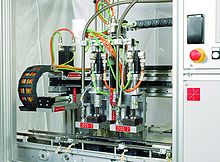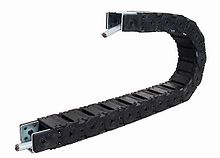Energy chain
The energy chain (also energy chain, e-chain or drag chain ) is a component in mechanical engineering that guides and protects flexible cables , pneumatic or hydraulic lines . Such cables are connected to a machine part that is constantly moved back and forth. Without such a guide that guarantees compliance with the smallest permissible bending radius of the cables, the cables would quickly be destroyed under constant load. Standardized individual elements enable such a chain to be set up according to the modular principle.
history
The energy chain was invented in 1953 by Gilbert Waninger, head of development at Waldrich Siegen GmbH . As a result, the Kabelschlepp company was founded a year later , producing steel cable carriers for large milling machines. Energy chains have also been made of all-plastic since 1969.
construction
There are many different designs. Most cable carriers have a rectangular cross-section with the cables inside. A start and an end piece are connected by many identical chain links. Often every chain link can be opened on the outside so that cables can easily be inserted even with connectors already installed. Longitudinal bars in the chain separate the cables from one another. At the beginning and the end, the cables are clamped with a strain relief . Cables suitable for drag chains are specially designed for frequent movement. In contrast to normal cables, they have some special properties: robust in movement, highly flexible and torsion-free (low-torsion), which allow between 1 and 3 million cycles. If normal cables were used, a maximum of 50,000 cycles would be possible. Most energy chains are made of plastic ( polypropylene , polyamide ). There are also metal versions for heavy hydraulic lines or large chains. The following variants are possible:
- open
- closed, protects against dirt, metal chips, welding beads
- low-noise / quiet
- Suitable for clean rooms , with little abrasion for clean rooms
- linkless / hinge-free as a band to which the cables are attached.
- 3D, for industrial robots with multiple degrees of freedom
Application examples

Energy chains are used wherever moving machine parts have to be supplied with energy , data, liquids or gases. Examples are machine tools , operating devices for high-bay warehouses , cranes , car washes, stage technology.
Alternatives
Electrical energy can also be transmitted with a pantograph , a slip ring , a busbar , a spring cable reel (with slip ring) or inductively into moving machine parts. Both electrical energy and data can also be transmitted with a trailing cable . Data can also be transmitted optically or increasingly with radio waves .
Individual evidence
- ↑ Guidelines for laying cables and wires (accessed on July 5, 2019)
Web links
- Energy chains and energy chain systems in steel and plastic (accessed on July 5, 2019)
- Construction guidelines The selection of the suitable energy chain (accessed on July 5, 2019)
- Cable drag energy chains (accessed on July 5, 2019)
- From the energy chain to wireless data transmission (accessed on July 5, 2019)


